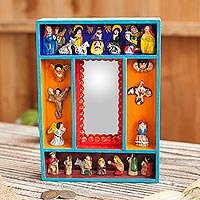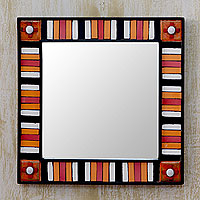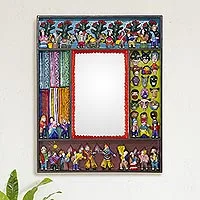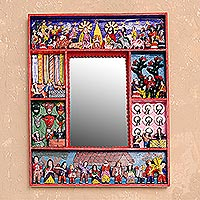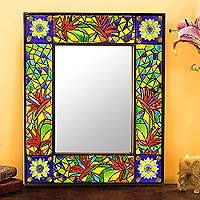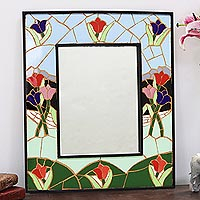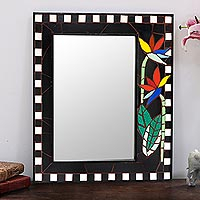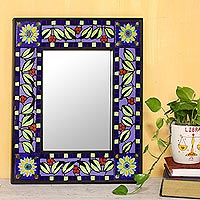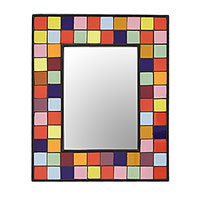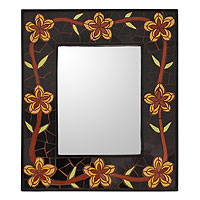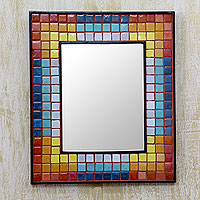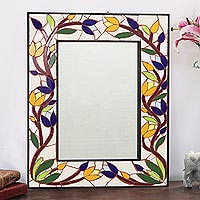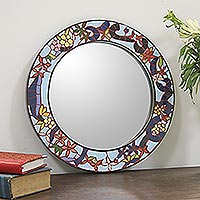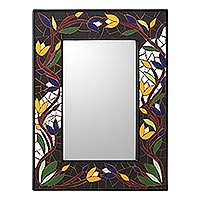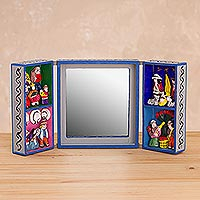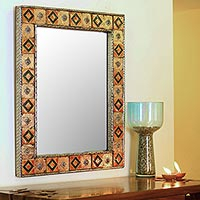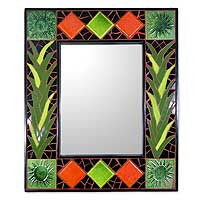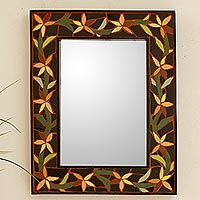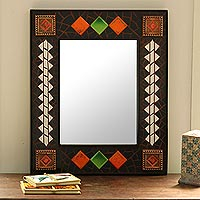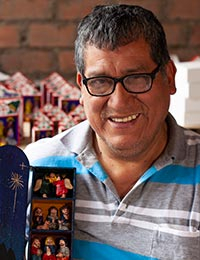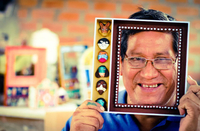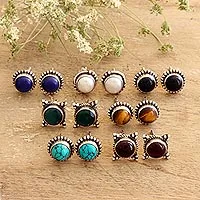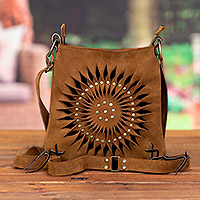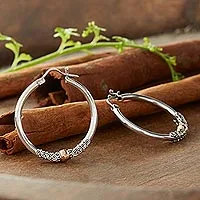Ceramic Mirrors
(23 items)NOVICA's Ceramic Mirrors Collection showcases traditional and contemporary designs, handcrafted by global artisans. From multicolored mosaics to hand-painted Talavera-style frames and folk art retablos, you will find a unique ceramic mirror to reflect your taste.
The Village Council
Your answers straight from the village experts
Different types of mirrors require different cleaning techniques. Gilded mirrors, for example especially vintage pieces may oxidize with the use of cleaning products or water, so it is best to simply and lightly dust their frame with a clean, soft cloth or brush. Most other styles have a frame that can be cleaned with a paper towel or soft, damp cloth. Glass and mirror cleaner is okay for the mirror itself, but we recommend spraying it onto the cloth first and not directly onto the mirror, as dripping chemicals stuck in the frame may cause damage over time. Be sure to dry the mirror when you are finished cleaning by wiping away any leftover moisture or cleaners.A well-ventilated area assists in keeping the mirror dry, and we recommend hanging your mirror in an area where it can be admired without the risk of nicks, wall leaks, or other issues.
Absolutely! Depending on the styles that suit your design needs, our mirrors are versatile, fun, and can be placed in a variety of spaces. You might even want two mirrors on perpendicular walls for greater perspective. Handcrafted mirrors show a natural diversity and uniqueness, so there is truly something for everyone.
There are a few simple ways to tell if your mirror is handmade. If you look closely, youll notice unique lines, markings, or painted stylized details that indicate that it is a one-of-a-kind piece. Mirrors made of wood typically display distinctive and intricate engraving, while painted mirrors often reveal unique brushstrokes, colors, and designs. Shapes and sizes of a particular motif may vary slightly, as no two handcrafted mirrors are exactly identical. This makes them all the more special.
Yes! At Novica, were passionate about protecting our planet, and we understand the importance of eco-friendly items. Andean artisan Luciana Sandovol prides herself on recycling discarded materials like cardboard, natural dyes, paper, and paints to use for her papier mache creations. Central America has also started introducing recycled natural fibers into their mirror-crafting. India utilizes mango wood, a fast-growing, dense, eco-friendly wood that is native to Southeast Asia, and harvested only after its fertile, fruit-bearing years.
A classic Mexican folk art is embossed tin, and this is often employed in mirror frames. In Thailand, the lavish lai rot nam technique ornate gilded motifs on smooth black lacquer has been used for more than 400 years. Balinese woodcarvers use their legendary skills to handcraft mirrors whose frames often depict the island's exuberant flora and fauna.The technique of reverse-painted glass is believed to have originated around 4 AD in Egypt, and arrived in Italy by the 13th century. In the 16th century, Italian and Spanish artisans were migrating to Peru, bringing the technique with them. Motifs are painted by hand on the reverse side of glass panes. These are inlaid into a wooden frame, achieving a wonderful clarity of colors.In addition, beautiful Peruvian baroque wall mirrors are handcrafted in the Andes. They are carved by hand and covered with aluminum or bronze leaf before they receive an aged patina. See how theyre made here: https://bit.ly/3r3DxTp
As with most handicrafts, the materials at hand are the ones most often used. Woods of all kinds with sleek surfaces to show off the grain, or carved by hand, or embellished with applications. Glass panes, gilt, natural fibers or fabrics are also perfect for mirrors, as are tooled leather or metal repousse, ceramic tiles, stone, resin or papier mache. Artisans the world over discover unique materials to craft innovative and attractive mirrors.
Wall mirrors and hand mirrors are perfect for artisans, as are tabletop mirrors. In fact, any mirror with a frame invites an infinity of creative designs and techniques.
Featured Reviews on Ceramic Mirrors
Wood retablo mirror, 'Love Divine'
By Beverly
Great Christmas gift!
I just love this and was so excited to gift it to special friends who already have a lifetime of accumulated decorations nothing like this!
Mirror, 'Party of Masks'
By Julia
Great Folkart
This is truly a whimsical mirror exhibiting masks in a miniature way. This was a gift for a person who has always collected the larger masks and she is thrilled.
Mirror, 'Scenes from the Andes'
By Carla
Beautiful Birthday Present
My daughter loved this beautiful mirror and Andes figures. The art work is very detailed and well made. It looks wonderful with all of her South American pottery and blankets.
Featured Artist
"Over the years, I perfected my abilities and became a master retablo craftsman. In some, I depict Biblical scenes and, in others, everyday life in the Andes."
Alejandro Chavez was born in Lima in 1956. He specializes in creating retablos, a kind of reverent diorama-altar typical of the Ayacucho region of... read more
Ceramic Mirrors
The Spring Catalog
Discover our unique collection of beautiful, handmade objects from around the world, inspired by more than a century of exploration.
SHOP THE CATALOG

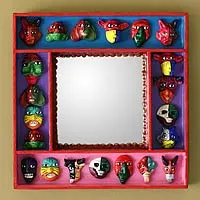 Bestseller
Bestseller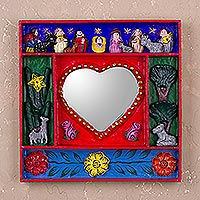 Bestseller
Bestseller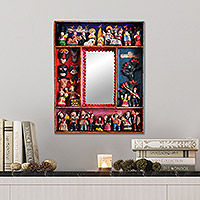 Bestseller
Bestseller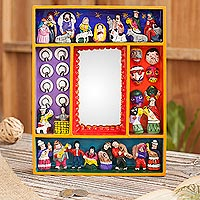 Bestseller
Bestseller